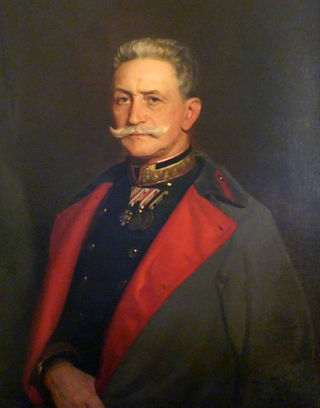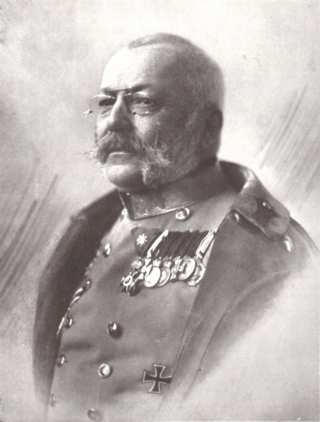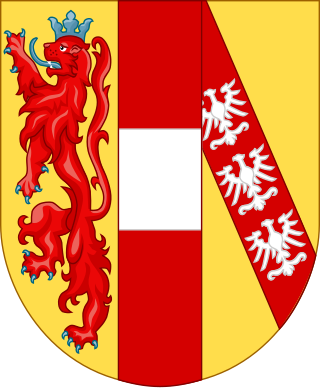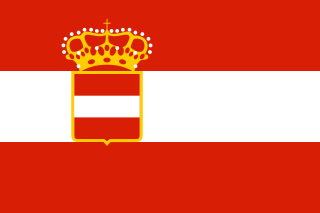
Franz Joseph I or Francis Joseph I was Emperor of Austria, King of Hungary, and the ruler of the other states of the Habsburg monarchy from 2 December 1848 until his death on 21 November 1916. In the early part of his reign, his realms and territories were referred to as the Austrian Empire, but were reconstituted as the dual monarchy of the Austro-Hungarian Empire in 1867. From 1 May 1850 to 24 August 1866, he was also president of the German Confederation.

Charles I or Karl I was Emperor of Austria, King of Hungary, King of Croatia, King of Bohemia, and the last of the monarchs belonging to the House of Habsburg-Lorraine to rule over Austria-Hungary. The son of Archduke Otto of Austria and Princess Maria Josepha of Saxony, Charles became heir presumptive of Emperor Franz Joseph when his uncle Archduke Franz Ferdinand of Austria was assassinated in 1914. In 1911, he married Princess Zita of Bourbon-Parma. He is venerated in the Catholic Church, having been beatified by Pope John Paul II on 3 October 2004, and is known to the Catholic Church as Blessed Karl of Austria.

The Brusilov offensive, also known as the "June advance", of June to September 1916 was the Russian Empire's greatest feat of arms during World War I, and among the most lethal offensives in world history. The historian Graydon Tunstall called the Brusilov offensive the worst crisis of World War I for Austria-Hungary and the Triple Entente's greatest victory, but it came at a tremendous loss of life. The heavy casualties eliminated the offensive power of the Imperial Russian Army and contributed to Russia's collapse the next year.

Franz Xaver Josef Conrad von Hötzendorf, sometimes anglicised as Hoetzendorf, was an Austrian general who played a central role in World War I. He served as K.u.k. Feldmarschall and Chief of the General Staff of the military of the Austro-Hungarian Army and Navy from 1906 to 1917. He was in charge during the July Crisis of 1914 that caused World War I.

Archduke Joseph August Viktor Klemens Maria of Austria, Prince of Hungary and Bohemia was a Feldmarschall of the Austro-Hungarian Army and for a short period head of state of Hungary. He was a member of the House of Habsburg-Lorraine, the eldest son of Archduke Joseph Karl of Austria (1833–1905) and his wife Princess Clotilde of Saxe-Coburg and Gotha (1846–1927). Joseph August's grandfather had been Palatine Joseph of Hungary (1776–1847), Palatine and Viceroy of Hungary, a younger son of Emperor Leopold II.

Archduke Friedrich, Duke of Teschen was a member of the House of Habsburg and the supreme commander of the Austro-Hungarian Army during World War I.

Archduke Albrecht Friedrich Rudolf Dominik of Austria, Duke of Teschen, was an Austrian Habsburg general. He was the grandson of Emperor Leopold II and one of the chief military advisors of Emperor Francis Joseph I. As Inspector General for 36 years, he was an old-fashioned bureaucrat who largely controlled the Austro-Hungarian Army and delayed modernization. He was honored with the rank of Field Marshal in the armies of Austria-Hungary (1863) and Germany (1893).
The 1st Army was a field army-level command in the ground forces of Austria-Hungary during World War I. The army fought in Galicia and Russian Poland in 1914–15 before being briefly dissolved in the summer of 1916. Shortly afterwards, it was reformed and sent to fight in the Romanian Campaign for the next two years. The 1st Army was demobilized in April 1918 due to its heavy losses, following Romania's surrender.

The Military Order of Maria Theresa was the highest military honour of the Habsburg monarchy, Austrian Empire and Austro-Hungarian Empire.

Archduke Joseph Ferdinand of Austria was an Austro-Hungarian Archduke, military commander, from 1916 Generaloberst, and early advocate of air power. He later retired to life as a common citizen of Austria, and was briefly imprisoned in Dachau during the Nazi era.

The House of Habsburg-Lorraine originated from the marriage in 1736 of Francis III, Duke of Lorraine and Bar, and Maria Theresa of Austria, later successively Queen of Bohemia, Queen of Hungary, Queen of Croatia and Archduchess of Austria. Its members are the legitimate surviving line of both the House of Habsburg and the House of Lorraine and inherit their patrimonial possessions and vocation to the Empire from their female line of the House of Habsburg and from the male line of the House of Lorraine.

The Order of Saint Stephen was an order of chivalry founded in 1764 by Maria Theresa. In 1938, Miklós Horthy took the rights and activities of Grand Master as Regent of Hungary. The name of the Order changed to the Royal Hungarian Order of Saint Stephen. The Order was terminated at the time of the proclamation of the Second Hungarian Republic in 1946. It was recreated in 2011 as the Hungarian Order of Saint Stephen, and to this day remains the highest order in Hungary.

Moritz Friedrich Joseph Eugen Freiherr Auffenberg von Komarów was an Austro-Hungarian Military officer in the Austro-Hungarian Army and Minister of War. At the outbreak of World War I, he took command of the Fourth Army.

The Battle of Komarow was a battle on the Eastern Front during World War I. It would prove a victory for the Austro-Hungarian forces, but one they would not be able to reproduce in the coming months of the war.

The Supreme Commander of the Imperial and Royal Armed Forces was the ultimate authority of the Austro-Hungarian Armed Forces – which comprised the Army, Navy and Aviation Troops of Austria-Hungary.

The leaders of the Central Powers of World War I were the political or military figures who commanded or supported the Central Powers.
The Army Group Mackensen which operated in Poland between 22 April 1915 and 8 September 1915 during World War I under the command of Field Marshal August von Mackensen, was an army group of the Imperial German Army.

The Austro-Hungarian Fourth Army was an Austro-Hungarian field army that fought during World War I.
The 3rd Army was a field army-level command within the ground forces of Austria-Hungary during World War I. It was primarily active on the Eastern Front against the Russian Empire and in the Balkans against Serbia and Montenegro. Later on, the 3rd Army took part in some fighting on the Italian Front before returning to the eastern theater by 1917 to repulse the Kerensky Offensive. Its remaining units were merged with the 7th Army in January 1918.

Army Group Archduke Karl was an army group of Austria-Hungary during World War I, established in June 1916 to fight against the Russian Empire on the Eastern Front and later in the campaign against the Kingdom of Romania. It was named for its commander, Field Marshal Archduke Karl Franz Joseph, who commanded the formation until October 1916. The following month, he became the last emperor of Austria-Hungary. The army group consisted of the 1st and 7th Armies.
















